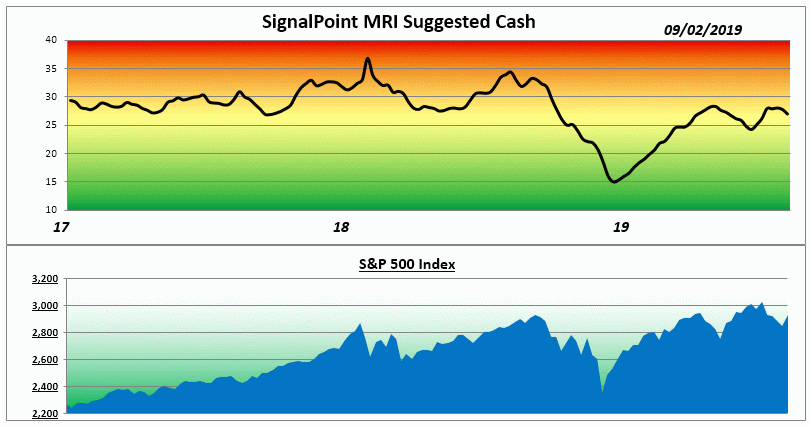From Chief Investment Officer Tom Veale,
“Here’s the September 3rd Headline from CNBC:
Anxiety-ridden August has investors bracing for a rough September, historically the worst month
SignalPoint’s Market Risk Indicator (MRI) has been telling us about investors being anxious for 6 weeks with a bearish signal from the MRI Divergence Index. It continues this week as well. However, because of the slide in the market indexes we’ve also seen the average Price/Earnings ratio decline as well. This week we see our Relative Valuation Index turn bullish for the first time since January 7th, 2019. The overall MRI score moved downward by one point to 27% suggested cash for diversified portfolios this week. Sometimes the “worst month” spells out best opportunity for contrary investing models.”

“Three MRI components declined in risk profile this week while only one rose only slightly. We did see the market breadth improve last week with advancing stocks outnumbering decliners by almost a 2:1 ratio. So, even with the CNBC headline, market risk as we measure it actually declined a small amount heading into September – back to just above its long term median value.
Along with a decline in the Price/Earnings Ratio we note the average yield of dividend paying stocks has risen slightly. Dividends didn’t go up, the price one has to pay for them has gone down. This puts the average yield of dividend paying stocks above even 30 year U.S. Treasury bonds. Investors start to pay attention to such things even when they’re nervous about the stock market. Could the bond market rally be nearing its peak? Yields suggest the line from “Oklahoma” – “They’ve gone about as far as they can go.” ”
The Market Risk Indicator is an assessment tool that serves as a guide through all markets as to the prudent use of a liquid cash cushion. It helps determine an approximation of the amount of cash reserve relative to a diversified equity portfolio. (this is depicted by the graph above)
At times of high risk in the market, the MRI will suggest a higher level of cash reserve. At times of low market risk, the MRI will suggest a lower level of cash reserve. This investment process helps to measure and manage market risk.
Because of this, the fear associated with the uncertainty of the market can be replaced by the security of a sound investment strategy.



